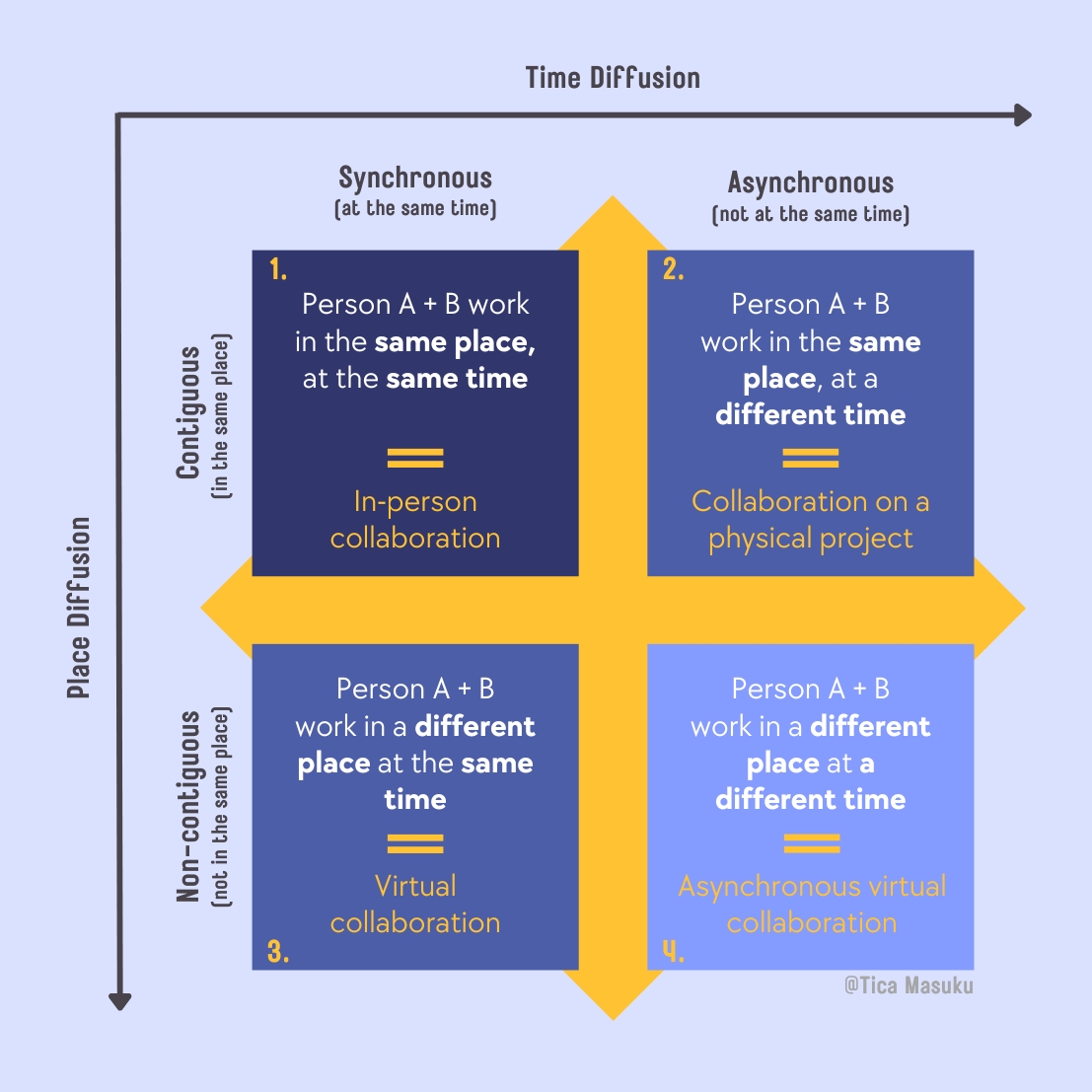
The Diffusion of Work
In the analogue world of the 1960s, knowledge work used to be largely concentrated in time and place. With people working standard 9-to-5 schedules (time) in centralised office locations (place). In the context of collaboration, this meant that interactions would predominantly occur synchronously in physical space (face to face meetings), synchronously in different spaces (through […]
In the analogue world of the 1960s, knowledge work used to be largely concentrated in time and place. With people working standard 9-to-5 schedules (time) in centralised office locations (place). In the context of collaboration, this meant that interactions would predominantly occur synchronously in physical space (face to face meetings), synchronously in different spaces (through traditional landline rotary phones), or asynchronously through the use of other analogue technologies such as Telex – where both Telex and rotary phones where still place-bound.
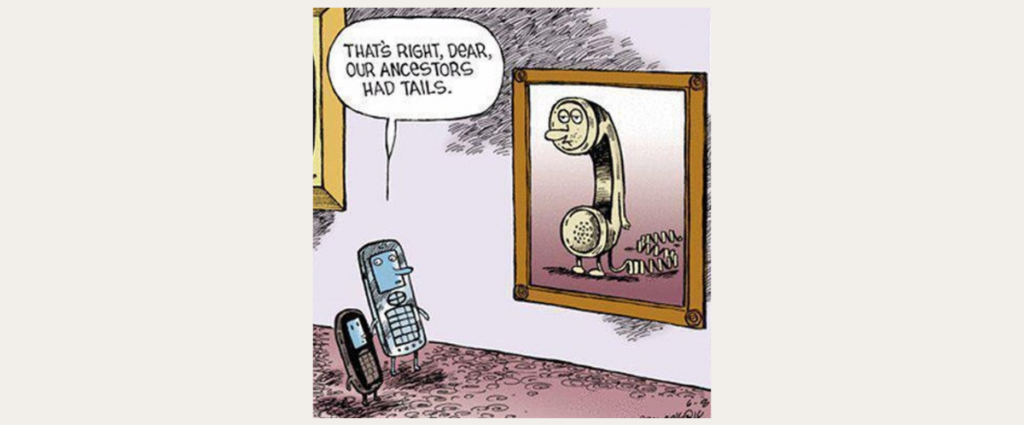
The ‘natural’ boundaries that once brought structure to our working days back in the 1960’s, have now evaporated as we’ve adopted a third dimension to our daily time-space experiences; the digital space. Or to quote Manual Castells whom much more eloquently described this evolution in his book Communication Power: “The development of communication technologies can be understood as the gradual decoupling of contiguity and time-sharing” (1). I like to call this phenomenon ‘the diffusion of work’; the increasing distribution of work across different locations (spatial spread) and across different times or periods (temporal spread):
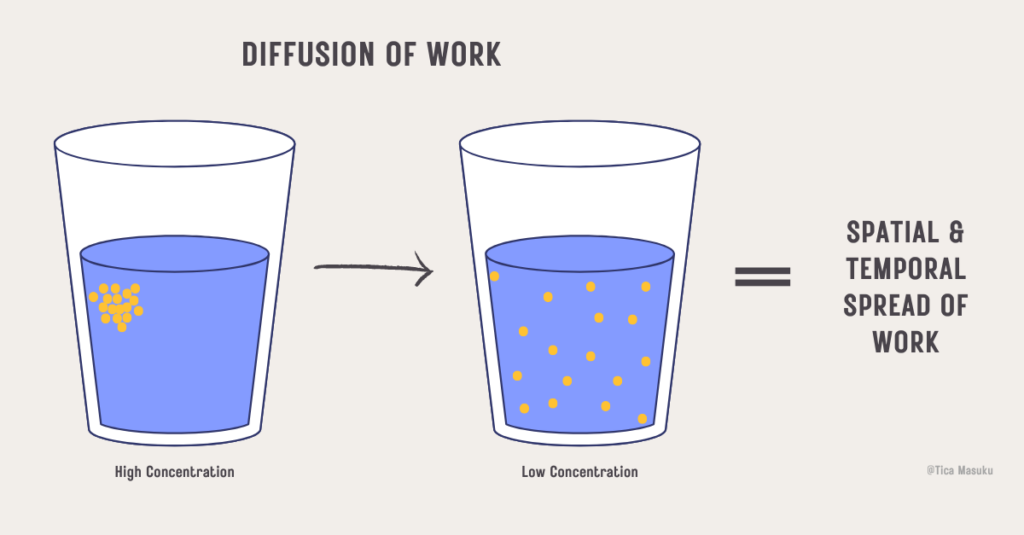
How does this diffusion of work impact how we experience work? Seeing that concentration of people in the same place at the same time (or similar timezone) is not straightforward anymore, it would be prudent to question; how are our work models differently now?
By utilising the fundamentals of time geography (time, space and human behaviour) we can shed light on the newly formed work models that have emerged with the development of communication technology. The below framework uses the axes to illustrate the fundamental elements of temporal and spatial diffusion for collaboration:
Time Diffusion:
- Synchronous (collaborate at the same time)
- Asynchronous (collaborate, but not at the same time)
Place Diffusion:
- Contiguous (collaborate in the same place)
- Non-Contiguous (collaborate, but not in the same place)
With these parameters, we’re able to delineate four distinct working modalities (human activities):
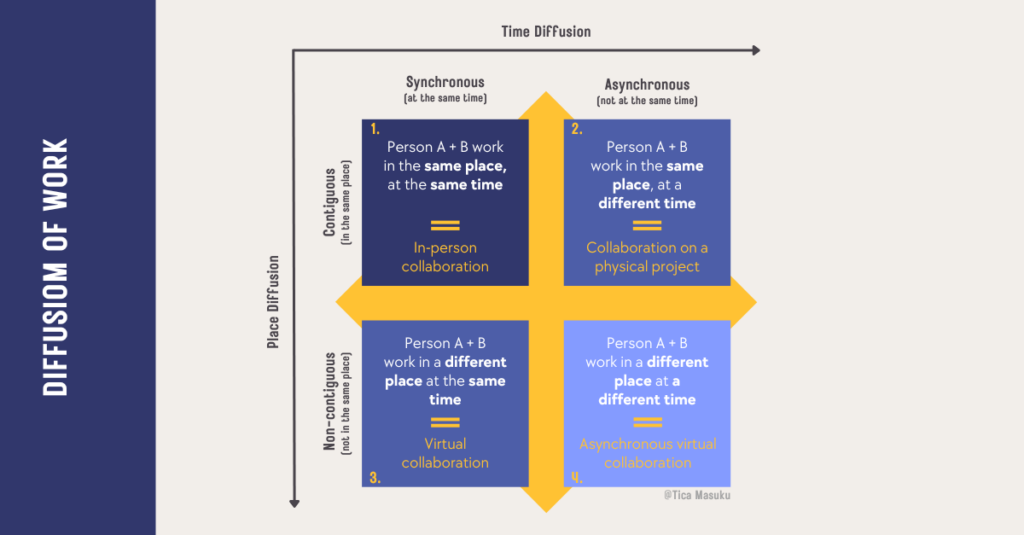
These working modalities show that through the removal of boundaries through the addition of the virtual dimension, we can now “practise simultaneity without contiguity” (Manual Castells), as well as an improvement on how we interact asynchronously & non-contiguously (think about shared docs, emails, Slack, Loom, etc.).
Fluidity of Work Models
Not only do we have access to a broader spectrum of work models, but the ease with which we can transition between them is remarkable.
Aside from access to a greater variety of work models, it’s now also easier to switch between the different modes of working. We can now much more seamlessly navigate across the more fluid non-spatial bound quadrants:
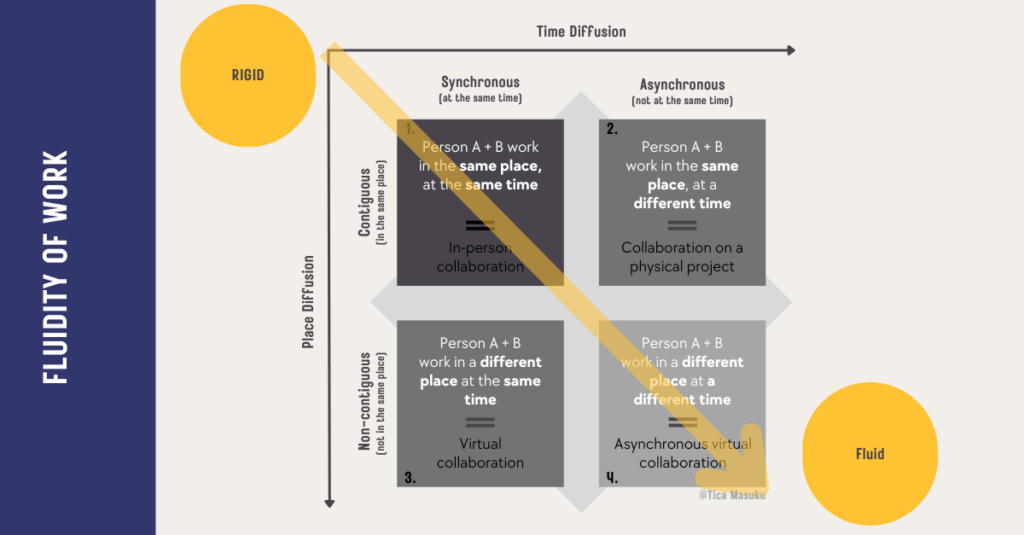
Such fluidity has the opportunity to strengthen business resilience. For example, when the Covid-19 pandemic hit, tasks that could be done regardless of geography could still continue. From a time perspective, various organisations across the world reap the benefits from having a global workforce; when east sleeps, west picks up and continues the work – which could bring a competitive advantage over companies that don’t.
Diffusion can bring confusion
However, the diffusion of work can also bring confusion. As we now have access to a variety of work models that are more fluid, we need to be conscious about how we go about our daily work rhythms. Many of us are, in fact, much more aware of where and when we conduct our work compared to say ten years ago. Having access to more work modality options does not necessarily simplify our decision-making process, especially when considering the effects on organisational culture, teamwork, and the equilibrium between personal and professional life.
This challenge was highlighted during the pandemic as well, which demonstrated that work could indeed be taking place from virtually anywhere, at any time, making it hard to set clear boundaries and actually switch off from work to recharge.
This diffusion of work has major implications for the commercial real estate sector too. As our perceptions of time & space are morphing and evolving, office buildings remain still quite rigid in both the spatial and temporal elements (think inflexible bricks and mortar, and long-term inflexible leases). How could real estate evolve to better support the fluidity of current work models?
Navigating the Confusion in Work Diffusion
Planning for future real estate needs of businesses has become an exceedingly challenging task. What work models work best for our dispersed teams, for individuals, and for organisations as a whole? The solution may well lie in a bespoke and comprehensive workplace strategy that reveals how and where your people perform at your best. A holistic workplace strategy must now encompass the entire ecosystem, considering all potential locales and timeframes for work activities. This complexity requires an innovative and flexible approach. By employing the three core elements of time geography – space, time, and human activities – we can introduce a sense of order and transparency to this emerging paradigm. As the need for a fixed work location diminishes, it’s important to re-conceptualise traditional office environments, adapt management techniques, and support workers too in navigating the variety and fluidity of work models.
How has the diffusion of work impacted your organisation? How are you experiencing the diffusion of work?
Nov 30, 2023
Tica Masuku
|
[🎤Are you looking for a keynote speaker for your next event, company off-site or global summit? I'm currently organising my international speaking calendar for 2025. Please get in touch to discuss the possibilities tica.m@spaceful.com.au]
[💡Would you like to know how I can help you or your organisation apply a human geography informed strategy to your workplace? I'm the Director of Workplace Strategy at Spaceful. We assist organisations design and develop bespoke and evidence-based workplace strategy solutions. You can email me at tica.m@spaceful.com.au]
You'll get...
Thank You for Subscribing!
Website designed by Creative Vibes
2025 © Copyright Tica Masuku